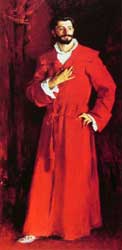(Frontpage) (What's New) (Thumbnails) (Refer This Site)
Harper's Magazine, Ocober,1887 (pp. 683-691)
| (page 2 of 9) |
| "John S. Sargent" by Henry James
(Frontpage) (What's New) (Thumbnails) (Refer This Site) Harper's Magazine, Ocober,1887 (pp. 683-691) |
|
 |
born of American parents, and where his fortunate youth had been spent. He entered immediately the studio of Carolus Duran, and revealed himself in 1877, at the age of twenty-two, in the portrait of his master—a fine model in more than one sense of the word. He was already in possession of a style; and if this style has gained both in delicacy and in assurance, it has not otherwise varied. As he saw and “rendered” ten years ago, so he sees and renders to-day; and I may add that there is no present symptom of his passing into another manner. Those who have appreciated his work most up to the present time emit no wish for a change, so completely does that work seem to them, in its kind, the exact translation of his thought, the exact “fit” of his artistic temperament. It is difficult to imagine a young painter being less in the dark about his own ideal, having from the first more the air of knowing what he desires. In an altogether exceptional degree does he give us the sense that an intention and the art of carrying it out are for him one and the same thing. In the brilliant portrait of Carolus Duran, which he was speedily and strikingly to surpass, he gave almost the full measure of this admirable peculiarity, that perception with him is already by itself a kind of execution. It is likewise so, of course, with many another genuine painter; but in Mr. Sargent’s case the process by which the object seen resolves itself into the object pictured is extraordinarily immediate. It is as if painting were pure tact of vision, a simple manner of feeling. From the time of his first successes at the Salon he was hailed, I believe, as a recruit of high value to the camp of the Impressionists, and to-day he is for many people most conveniently pigeon-holed under that head. It is not necessary to protest against the classification if this addition always be made to it, that Mr. Sargent’s impressions happen to be interesting. This is by no means inveterately the case with those of the ingenuous artists who most rejoice in the title in question. To render the impression of an object may be a very fruitful effort, but it is not necessarily so; that will depend upon what, I won’t say the object, but the impression, may have been. The talents engaged in this school lie, not unjustly, as it seems to me, under the suspicion of seeking the solution of their problem exclusively in simplification. If a painter works for other eyes as well as his own, he courts a certain danger in this direction —that of being arrested by the cry of the spectator: “Ah! but excuse me; I myself take more impressions than that.” We feel a synthesis not to be an injustice only when it is rich. Mr. Sargent simplifies, I think, but he simplifies with style, and his impression in most cases is magnificent. His work has been almost exclusively
in portraiture, and it has been his fortune to paint more women than men;
therefore he has had but a limited opportunity to reproduce that generalized
grand air with which his view of certain figures of gentlemen invests the
model, which is conspicuous in the portrait of Carolus
Duran, and of which his splendid “Docteur
Pozzi,” the distinguished Paris surgeon (a work not sent to the Salon),
is an admirable example. In each of these cases the model has been of a
gallant pictorial type, one of the types which strike us as made for portraiture
(which is by no means the way of all), as especially appears, for instance,
in the handsome hands and frilled wrists of M. Carolus, whose cane rests
in his fine fingers as if it were the hilt of a rapier. The most brilliant
of all Mr. Sargent’s productions is the portrait of a young lady [Madame
Ramon Subercaseaux], the magnificent picture which lie exhibited
in 1881; and if it has mainly been his fortune since to commemorate the
fair faces of women, there is no ground for surprise at this sort of success
on the part of one who had given so signal a proof of his having the secret
of the particular aspect that the contemporary lady (of any period) likes
to wear in the eyes of posterity. Painted when he was but four-and-twenty
years of age, the picture by which Mr. Sargent was represented at the Salon
of 1881 is a performance which may well have made any critic of imagination
rather anxious about his future. In common with the superb group of the
children of Mr. Edward Boit, exhibited two years later, it offers the
slightly “uncanny” spectacle of a talent which on the very threshold of
its career has nothing more to learn. It is not simply precocity in the
guise of maturity—a phenomenon we very often meet, which deceives us only
for an hour; it is the freshness of youth combined with the artistic experience,
really felt and assimilated, of generations. My admiration for this deeply
distinguished work is such that I am perhaps in danger of over-
Note: |

Carolus Duran 1879 


Dr. Samuel Jean Pozzi at Home 1881 
Madame Ramon Subercaseaux 1880 Exhibed at the Salon 1881 
Daughters of Edward Darley Boit 1882 |

By: Natasha
Wallace
Copyright 1998-2001 all rights reserved
Created September 28, 2001
Updated October 3, 2001